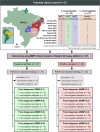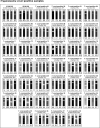Western blot using Trypanosoma cruzi chimeric recombinant proteins for the serodiagnosis of chronic Chagas disease: A proof-of-concept study
- PMID: 36441769
- PMCID: PMC9731424
- DOI: 10.1371/journal.pntd.0010944
Western blot using Trypanosoma cruzi chimeric recombinant proteins for the serodiagnosis of chronic Chagas disease: A proof-of-concept study
Abstract
Background: Chagas disease (CD) is caused by Trypanosoma cruzi. The chronic phase of CD is characterized by the presence of IgG anti-T. cruzi antibodies; and diagnosis is performed by serological methods. Because there is no reliable test that can be used as a reference test, WHO recommends the parallel use of two different tests for CD serodiagnosis. If results are inconclusive, samples should be subjected to a confirmatory test, e.g., Western blot (WB) or PCR. PCR offers low sensitivity in the chronic phase, whereas few confirmatory tests based on the WB method are commercially available worldwide. Therefore, new diagnostic tools should be evaluated to fill the gap in CD confirmatory tests. In recent years, four chimeric recombinant antigens (IBMP-8.1, IBMP-8.2, IBMP-8.3 and IBMP-8.4) have been evaluated in phase I, II and III studies using ELISA, liquid microarray and immunochromatography with 95-100% accuracy. Given the high diagnostic performance of these antigens, the present study investigated the ability of these molecules to diagnose chronic CD using a WB testing platform.
Methodology/principal findings: In this study, we analyzed the diagnostic potential of four chimeric antigens using 40 T. cruzi-positive, 24-negative, and three additional positive samples for visceral leishmaniasis (i.e., potentially cross-reactive) using WB as the diagnostic platform. Checkerboard titration with different dilutions of antigens, conjugated antigens, and serum samples was performed to standardize all assays. All IBMP antigens achieved 100% sensitivity, specificity, and accuracy, with the exception of IBMP-8.3, which had 100% specificity despite lack of significance, but lower sensitivity (95%) and accuracy (96.9%). No cross-reactivity was observed in samples positive for leishmaniasis.
Conclusions/significance: The present phase I (proof-of-concept) study demonstrated the high diagnostic potential of these four IBMP antigens to discriminate between T. cruzi-positive and -negative samples, making them candidates for phase II and confirmatory testing with WB.
Copyright: © 2022 Daltro et al. This is an open access article distributed under the terms of the Creative Commons Attribution License, which permits unrestricted use, distribution, and reproduction in any medium, provided the original author and source are credited.
Conflict of interest statement
The authors have declared that no competing interests exist.
Figures





Similar articles
-
Evaluation of chimeric recombinant antigens for the serodiagnosis of Trypanosoma cruzi in dogs: a promising tool for Chagas disease surveillance.Parasit Vectors. 2024 Jul 15;17(1):305. doi: 10.1186/s13071-024-06376-5. Parasit Vectors. 2024. PMID: 39010122 Free PMC article.
-
Accuracy of chimeric proteins in the serological diagnosis of chronic chagas disease - a Phase II study.PLoS Negl Trop Dis. 2017 Mar 8;11(3):e0005433. doi: 10.1371/journal.pntd.0005433. eCollection 2017 Mar. PLoS Negl Trop Dis. 2017. PMID: 28273127 Free PMC article.
-
Cross-Reactivity Using Chimeric Trypanosoma cruzi Antigens: Diagnostic Performance in Settings Where Chagas Disease and American Cutaneous or Visceral Leishmaniasis Are Coendemic.J Clin Microbiol. 2019 Jul 26;57(8):e00762-19. doi: 10.1128/JCM.00762-19. Print 2019 Aug. J Clin Microbiol. 2019. PMID: 31189586 Free PMC article.
-
Performance of recombinant chimeric proteins in the serological diagnosis of Trypanosoma cruzi infection in dogs.PLoS Negl Trop Dis. 2019 Jun 26;13(6):e0007545. doi: 10.1371/journal.pntd.0007545. eCollection 2019 Jun. PLoS Negl Trop Dis. 2019. PMID: 31242195 Free PMC article.
-
Technological advances in the serological diagnosis of Chagas disease in dogs and cats: a systematic review.Parasit Vectors. 2022 Sep 27;15(1):343. doi: 10.1186/s13071-022-05476-4. Parasit Vectors. 2022. PMID: 36167575 Free PMC article. Review.
Cited by
-
Chagas Disease across the Ages: A Historical View and Commentary on Navigating Future Challenges.Microorganisms. 2024 Jun 6;12(6):1153. doi: 10.3390/microorganisms12061153. Microorganisms. 2024. PMID: 38930535 Free PMC article.
-
IgG Isotypes Targeting a Recombinant Chimeric Protein of Trypanosoma cruzi in Different Clinical Presentations of Chronic Chagas Disease.Am J Trop Med Hyg. 2024 Feb 27;110(4):669-676. doi: 10.4269/ajtmh.23-0652. Print 2024 Apr 3. Am J Trop Med Hyg. 2024. PMID: 38412539 Free PMC article.
-
In vitro diagnostic methods of Chagas disease in the clinical laboratory: a scoping review.Front Microbiol. 2024 Apr 30;15:1393992. doi: 10.3389/fmicb.2024.1393992. eCollection 2024. Front Microbiol. 2024. PMID: 38746745 Free PMC article.
-
Assessment of Cross-Reactivity of Chimeric Trypanosoma cruzi Antigens with Crithidia sp. LVH-60A: Implications for Accurate Diagnostics.Diagnostics (Basel). 2023 Nov 17;13(22):3470. doi: 10.3390/diagnostics13223470. Diagnostics (Basel). 2023. PMID: 37998606 Free PMC article.
References
-
- WHO. Chagas disease in Latin America: an epidemiological update based on 2010 estimates. Wkly Epidemiol Rec. 2015;90: 33–43. - PubMed
Publication types
MeSH terms
Substances
Grants and funding
LinkOut - more resources
Full Text Sources
Medical
Miscellaneous

